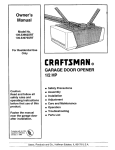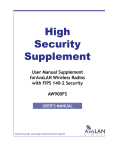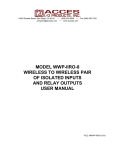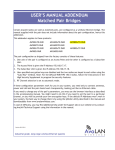Download AW900mTR-EVAL - AvaLAN Wireless
Transcript
AW900mTR-EVAL USER’S MANUAL 900 MHz Wireless Ethernet Module Evaluation Kit Industrial-grade, long-range wireless Ethernet systems AvaLAN W I R E L E S S AW900mTR User’s Manual Thank you for your purchase of the AW900mTR-EVAL Wireless Ethernet Module Evaluation Kit. If you have any questions when configuring your AvaLAN system, the best place to get answers is to visit www.avalanwireless.com. You will also find the latest updates there. If more assistance is needed, send email to [email protected]. To speak to a live technician, please call technical support at the number below during normal business hours. Note: Professional installation is required when using the sector antenna. Limited Warranty This product is warranted to the original purchaser for normal use for a period of 360 days from the date of purchase. If a defect covered under this warranty occurs, AvaLAN will repair or replace the defective part, at its option, at no cost. This warranty does not cover defects resulting from misuse or modification of the product. © AvaLAN Wireless Systems Inc. All rights reserved. Revision 01.31.2014 125A Castle Drive Madison, AL 35758 Sales: (866) 533-6216 Technical Support: (650) 384-0000 Customer Service: (650) 641-3011 Fax: (650) 249-3591 Technical support (650) 384-0000 PAGE 2 www.avalanwireless.com User’s Manual AW900mTR Operational summary The AW900mTR Radio Module allows the user to create a long-range, wireless Ethernet network with up to 16 subscriber units per access point. The configuration may include any combination of AW900mTR, AW900xTR, AW900iTR and AW900xTP radios. (Please note that older AvaLAN 900 MHz radios can exist on the same LAN but cannot be used to form wireless links with the AW900mTR because link encryption protocols have changed.) Configuring a wireless link with the AW900mTR requires the establishment of six elements: • Each radio must know whether it is to be an access point (AP) or subscriber unit (SU). • Each radio must have an IP address that is unique among all others on the same network. • The AP must know how many SUs are expecting communication with it. • The AP and any given SU must agree on which radio frequency channel they are using. This can be manually set or allowed to change automatically. • The SU must be assigned a unique subscriber ID to specify which time division slot it will use when communicating with the AP. • The AP and any given SU must share a common 128-bit encryption key. AW900mTR radios may be configured by two different methods. They may be connected to a computer that will run a web browser, setting parameters via their built-in browser interfaces. They may also be programmed via the “easy key” method using the DIP switches and LEDs on the module. The access point (AP) automatically scans for the best of the 12 available radio frequency channels, encrypts Ethernet data received from the network, and transmits it wirelessly to the correct subscriber unit (SU). The AP is constantly monitoring the radio link and can automatically change the channel if performance is degraded due to interference. If two AP units are very close to one another, they may interfere if operating on adjacent frequency channels. Place them at least 10 feet apart or manually select non-adjacent channels for their operation. Also, the SU should be placed at least 10 feet from the AP to avoid overloading the radio’s receiver. Any 10/100 BaseT Ethernet client device (ECD) can be connected to an AW900mTR subscriber unit. Each SU encrypts Ethernet traffic received from the attached ECD and transmits the data wirelessly to its AP. Each SU can be plugged directly into an ECD without adding drivers or loading software. Essentially, once the AP/SU pair is configured and running it behaves like a continuous Ethernet cable. Technical support (650) 384-0000 PAGE 3 www.avalanwireless.com AW900mTR User’s Manual Evaluation Kit Contents The AW900mSPI-EVAL 900 MHz Wireless Ethernet Module Evaluation Kit contains two each of the following items: • • • • • AW900mSPI Wireless Ethernet Modules AW2-900 Omnidirectional Antennas AW-P8 Antenna to Radio Connectors AW-POE Power Over Ethernet Injectors AW-12VPS 12 Volt Power Supplies Additional quantities of any of these components may be purchased from AvaLAN Wireless or our distributors. To power up a radio module, connect the antenna via the pigtail cable provided. Connect an Ethernet cable to the RJ-45 jack on the module. Power may be supplied to the module using the 12 VDC wall hanger power supply either through the Ethernet cable using the POE or directly into the P5 jack on the module. Provide some physical separation between two radio modules — at least five feet. If their antennas are in close proximity, the module radio receivers will be overloaded, causing degredation in the bit error rate and slower link performance. Technical support (650) 384-0000 PAGE 4 www.avalanwireless.com User’s Manual AW900mTR Physical Dimensions Power: 5-48 VDC Ethernet: 10/100T Power: 9-48 VDC Mounting Holes 23 mm 66 mm 70 mm Antenna: Reverse polarity SMA Mounting Holes 900 MHz Channels Channel 0 1 2 3 4 5 6 7 8 9 10 11 12 Technical support (650) 384-0000 Center Frequency Auto Mode 903.12500 MHz 905.20833 MHz 907.29167 MHz 909.37500 MHz 911.45833 MHz 913.54167 MHz 915.62500 MHz 917.70833 MHz 919.79167 MHz 921.87500 MHz 923.95833 MHz 926.04167 MHz PAGE 5 www.avalanwireless.com AW900mTR User’s Manual Browser Interface Configuration 1. Digital configuration is done by means of the AW900mTR’s built in browser interface. It should be powered on and connected at least temporarily to a network containing a computer that can run a conventional web browser. 2. Download the AvaLAN IP Discovery Utility from our website and extract ipfinder.exe from the zip archive, placing it on your desktop or in a convenient folder. http://www.avalanwireless.com/ipfinder/ipfinder.zip Note that this utility only runs on MS Windows, not linux or MAC. If you must use a nonWindows computer for configuration, make sure your subnet mask allows your computer to see 192.168.17.17. Connect to that default IP address with your web browser, continuing the setup procedure with step 6. 3. Run the IP Discovery Utility, ipfinder.exe and you should see a window similar to this: The AW900mTR should appear in the list at the default IP address of 192.168.17.17. If it does not, click “Search” to regenerate the list. If it still does not appear, you have a connection issue and need to re-examine the cabling or you may have a firewall issue on your computer. 4. Double click the list item that refers to the AW900mTR being configured. You should see a second window that is similar to this: The information on the left is the current status of the radio, while the boxes on the right allow you to change it. It is important that the IP address of the AW900mTR is in the same subnet as your computer. For example, if the subnet mask is 255.255.255.0 ( a class C network), the first three number groups of the IP address must match. Choose your desired parameters and click “Apply.” Technical support (650) 384-0000 PAGE 6 www.avalanwireless.com User’s Manual AW900mTR 5. Make note of the chosen IP address and password, then click “Go to Device Web Page.” This will cause your default web browser to launch with the device IP address in the browser address bar. Or you may launch the browser on your own and enter the web page address manually: http://[the IP address you just set]. 6. The browser page that loads first shows the current device information and QoS statistics and provides a login at the upper right. Log in using the password you just specified (or “password” if you kept the default). If the login succeeds, you will see an admin page similar to this: 7. The admin page has sections similar to the login page showing radio statistics and device information plus it adds several new sections. The Device Settings section allows setting the network information and choosing an RF frequency channel. The default is to allow the radio to choose its own frequency based on minimizing interference. If you set a fixed channel, make sure the AP and all SUs use the same one. References to DIPs on this and the next web page refer to the DIP switches on the module that are used in the “easy key” method of configuration and may be ignored when using the browser method. If you scroll down in the Admin browser page, you will come to three more sections: • A graphical spectrum analyzer display that may help you to select radio channels that avoid interference • A section to be used if an update to the AW900mTR’s firmware is required • An Advanced Links section with a dire warning about advanced users only. Technical support (650) 384-0000 PAGE 7 www.avalanwireless.com AW900mTR User’s Manual Despite the warning, you will need to click the “Advanced Admin” button in order to set the device type, ID and encryption key. You should then see a page similar to this: 8. On the Advanced Admin page, set the parameters as follows: • Choose Device Type: Access Point or Subscriber Unit. • For Subscriber Units, assign unique ID numbers in numeric order from 1 to 63. • For an Access Point, enter the number of Subscriber Units that will be communicating with it. • Click the box labeled “Enable User Specified Keys.” • Choose an 8-digit hex (0-9 and A-F) Network Name that will be common among the AP and its SUs and enter it. The hyphen is required. • Choose a 32-digit hex encryption key and enter it. Again, the hyphens are required. This key must match between the AP and the SU so make a note of it as well. After entering the parameters, click the “Apply” button to save them to the module. 9. When all of the radios are keyed and operating, connect them to your network and Ethernet devices as desired and cycle the radio module’s power to begin normal operation. Now, browser management of the SUs can be performed over the wireless network. Note: avoid plugging actively linked radios into the same switch because this will corrupt its routing table and may cause network problems just as if you had plugged a CAT5 cable directly between two ports of a switch. Technical support (650) 384-0000 PAGE 8 www.avalanwireless.com User’s Manual AW900mTR LED and Switch Behavior Reset Switch: Press momentarily for soft reset of processor. Hold for 10 seconds to reset module to factory defaults. LEDs PWR RX TX ETH CH1 CH2 CH4 CH8 CH16 CH32 DIP Switches 1 2 3 4 5 6 7 8 LINK QUALITY LED PWR RX TX ETH CH1 CH2 CH4 CH8 CH16 CH32 Function Color Red Green Green Green Green Shows link quality (more lit the better) or indicates “key exchange mode” if blinking sequentially Excellent link quality: no retransmissions Very good link quality: few retransmissions Good link quality: occasional retransmissions Fair link quality: some retransmissions Poor link quality: frequent retransmissions No link quality: no link available DIP Switch Function (up is off, down is on) Green Green Amber Amber Red Red 1 2 3-8 Unit has power and has successfully booted Radio reception is occuring Radio transmission is occuring Ethernet port is connected By adding the numbers that are lit, you can determine the current radio channel. Valid channels are 1 to 12, CH16 and CH32 are not used. For the frequency of each channel, see the table on page 5. Set on for Access Point, off for Subscriber Unit Test switch for tech support use. Leave off All off: automatic frequency selection. To manually set the channel, set switches on in same pattern as the channel LEDs: Switch 3 is bit 1, switch 4 is bit 2, switch 5 is bit 4, etc. Technical support (650) 384-0000 PAGE 9 www.avalanwireless.com AW900mTR User’s Manual “Easy Key” Configuration In most cases, the browser interface is a better choice for configuring the modules. But they also can be configured as a point-to-point bridge or a point-to-multipoint group using the DIP switches. When this method is used, the module that will operate as the access point provides a unique network ID calculated from its MAC address and a unique random encryption key programmed into it during manufacture. If you do configure a set of modules this way, be aware that they will all have the factory default IP address of 192.168.1.17. If you later need access to a module via the browser interface, use the IP Finder utility, select the individual unit and give it a unique IP address. Initial Setup: 1. Select the module that will operate as the access point (AP) and set its DIP switch 1 on (down). Set DIP switch 1 off (up) on the module(s) that will operate as subscriber units (SUs). 2. Select matching frequency channels on all modules or select automatic channel selection by leaving DIP switches 3-8 off. 3. Power up the AP module. Its link quality LEDs will begin blinking sequentially, showing that the module is hunting for an SU to exchange keys with. 4. Power up an SU module (its DIP switch 1 is off). This module’s link quality LEDs will also begin blinking sequentially showing that it is hunting for an AP to supply a network key. 5. Connect an Ethernet cable from the AP module to the SU module and the two modules will automatically exchange keys. (Do not connect through a switch or hub, but cable directly with a regular patch or crossover cable.) • On the AP module, the link quality LEDs will still blink sequentially in key exchange mode and the TX LED will light showing successful key exchange • On the SU module, the link quality LEDs will no longer blink sequentially, but one of the green link quality LEDs will slowly blink to indicate successful key exchange. 6. Repeat steps 4 and 5 for any other SU modules to be configured to the same AP. 7. disconnect the Ethernet cable and cycle power on all modules for the new keys to take effect. LED behavior should reflect normal RF operation once the units are deployed. Technical support (650) 384-0000 PAGE 10 www.avalanwireless.com User’s Manual AW900mTR To add a new SU to the AP, disconnect the AP from the network and power off. Connect an Ethernet cable between the SU and AP. Power up the SU FIRST and then the AP. The SU will receive the key. Disconnect the Ethernet cable and cycle power on the SU to cause the new keys to take effect. To re-key SUs to a new AP, proceed as in the inital setup, making sure to power up the AP FIRST. Technical specifications Characteristic Specification/Description RF transmission rate 1.536 Mbps Ethernet data rate 935 Kbps Output Power +21 dBm (4 Watts EIRP with 15 dBi antenna) Receive Sensitivity -97 dBm at 10-4 Bit Error Rate Range Up to 40 miles line-of-sight with 15 dBi antennas RF channels/bandwidth 12 non-overlapping with 2.0833 MHz spacing and 1.75 MHz bandwidth Channel selection Automatic or manual via DIP switches or browser interface Adjacent band rejection SAW receiver filter attenuates cellular and pager interference Error correction Sub-block error detection and retransmission Encryption 128-bit AES, meets FIPS 197 Standard Browser Management Tools QoS statistics, network settings, spectrum analyzer Status LEDs Power, RF activity, Ethernet connect, channel, link quality Connectors RF: RPSMA Female, Ethernet: RJ-45, Power: P5, 2.1 mm ID Power consumption Transmit: 1.7 Watts, Receive: 0.8 Watts Voltage 9-48 VDC, power over Ethernet pins 4,5 positive, 7,8 ground or via separate P5 jack Power regulation Switching regulator Transmit current draw 175 ma at 9 VDC 140 ma at 12 VDC 35 ma at 48 VDC Operating Temperature Range -40 ºC to +80 ºC Size 70 by 66 by 23 mm, 40 grams Technical support (650) 384-0000 PAGE 11 www.avalanwireless.com AW900mTR User’s Manual FCC Certification The AW900MTR OEM RF Module complies with Part 15 of the FCC rules and regulations. Compliance with labeling requirements, FCC notices and antenna regulations is required. Labeling Requirements In order to inherit AvaLAN’s FCC Certification, compliance requires the following be stated on the device and within its operation manual: FCC ID: R4N-AW900MR This device complies with Part 15 of the FCC Rules. Operation is subject to the following two conditions: (1) this device may not cause harmful interference and (2) this device must accept any interference received, including interference that may cause undesired operation. Label Warning WARNING The Original Equipment Manufacturer (OEM) must ensure that FCC labeling requirements are met. This includes a clearly visible label on the outside of the final product enclosure that displays the contents shown in the figure below. Figure A.1. Required FCC Label for OEM products containing the AvaLAN AW900MR OEM RF Module Contains FCC ID: R4N-AW900MR The enclosed device complies with Part 15 of the FCC Rules. Operation is subject to the following two conditions: (1) this device may not cause harmful interference and (2) this device must accept any interference received, including interference that may cause undesired operation. FCC Notices Adherence to the following is required: IMPORTANT: The AW900MR OEM RF Modules have been certified by the FCC for use with other products without any further certification (as per FCC section 2.1091). Changes or modifications not expressly approved by AvaLAN could void the user’s authority to operate the equipment. IMPORTANT: OEMs must test their final product to comply with unintentional radiators (FCC section 15.107 and 15.109) before declaring compliance of their final product to Part 15 of the FCC Rules. IMPORTANT: The AW900MR OEM RF Modules have been certified for fixed base station and mobile applications. If modules will be used for portable applications, the device must undergo SAR testing. Note: This equipment has been tested and found to comply with the limits for a Class B digital device, pursuant to Part 15 of the FCC Rules. These limits are designed to provide reasonable protection against harmful interference in a residential installation. This equipment generates, uses and can radiate radio frequency energy and, if not installed and used in accordance with the instructions, may cause harmful interference to radio communications. However, there is no guarantee that interference will not occur in a particular installation. If this equipment does cause harmful interference to radio or television reception, which can be determined by turning the equipment off and on, the user is encouraged to try to correct the interference by one or more of the following measures: • Reorient or relocate the receiving antenna. • Increase the separation between the equipment and receiving module. • Connect the equipment into an outlet on a circuit different from that to which the receiving module is connected. • Consult the dealer or an experienced radio/TV technician for help. FCC-Approved Antennas (900 MHz) Fixed Base Station and Mobile Applications AvaLAN Modules are pre-FCC approved for use in fixed base station and mobile applications. When the antenna is mounted at least 23 cm (9.06”) from nearby persons, the application is considered a mobile application. Portable Applications and SAR Testing When the antenna is mounted closer than 23 cm to nearby persons, then the application is considered “portable” and requires an additional test be performed on the final product. This test is called the Specific Absorption Rate (SAR) testing and measures the emissions from the module and how they affect the person. RF Exposure (This statement must be included as a CAUTION statement in OEM product manuals.) WARNING: This equipment is approved only for mobile and base station transmitting devices. Antenna(s) used for this transmitter must be installed to provide a separation distance of at least 23 cm from all persons and must not be co-located or operating in conjunction with any other antenna or transmitter. Antenna Warning WARNING: This device has been tested with Reverse Polarity SMA connectors with the antennas listed in Table 1 below. When integrated into OEM products, fixed antennas require installation preventing end-users from replacing them with non-approved antennas. Antennas not listed in the table below must be tested to comply with FCC Section 15.203 (unique antenna connectors) and Section 15.247 (emissions). To fulfill FCC Certification requirements: 1. Integrator must ensure required text [Figure 1] is clearly placed on the outside of the final product. 2. AW900MR Module may be used only with Approved Antennas that have been tested with this module. Antenna Type Dipole Omni Panel Yagi Sector* Maximum Gain ≤ 2dBi ≤ 11dBi ≤ 12.5dBi ≤ 16dBi ≤ 18.5dBi This Ethernet Module is approved for use only with specific antenna, cable, and output power configurations that have been tested and approved for use. Modifications to the module, the antenna system, or to the power output that have not been explicitly specified by the manufacturer are not permitted and may render the radio non-compliant with applicable regulatory authorities. The radio equipment described in this manual emits radio frequency energy. Professional installation is required. The antenna(s) for this transmitter must not be collocated or operated in conjunction with any other antenna ortransmitter. When using the sector antenna to ensure cable attentuation between the radio module and antenna is atleast 1.4dB to maintain compliance to FCC/IC EIRP limits. The recommended cable length when using the sector antenna is 10ft of LMR200 cable. Technical support (650) 384-0000 PAGE 12 www.avalanwireless.com User’s Manual AW900mTR IC (Industry Canada) Certification Labeling requirements for Industry Canada are similar to those of the FCC. A clearly visible label on the outside of the final product enclosure must display the following text: Contains Model AW900MR Radio, IC: 5303A-AW900MR Integrator is responsible for its product to comply with IC ICES-003 & FCC Part 15, Sub. B - Unintentional Radiators. ICES-003 is the same as FCC Part 15 Sub. B and Industry Canada accepts FCC test report or CISPR 22 test report for compliance with ICES-003. Under Industry Canada regulations, this radio transmitter may only operate using an antenna of a type and maximum (or lesser) gain approved for the transmitter by Industry Canada. To reduce potential radio interference to other users, the antenna type and its gain should be so chosen that the equivalent isotropically radiated power (e.i.r.p.) is not more than that necessary for successful communication. Conformément à la réglementation d’Industrie Canada, le présent émetteur radio peut fonctionner avec une antenne d’un type et d’un gain maximal (ou inférieur) approuvé pour l’émetteur par Industrie Canada. Dans le but de réduire les risques de brouillage radioélectrique à l’intention des autres utilisateurs, il faut choisir le type d’antenne et son gain de sorte que la puissance isotrope rayonnée équivalente (p.i.r.e.) ne dépasse pas l’intensité nécessaire à l’établissement d’une communication satisfaisante. This radio transmitter has been approved by Industry Canada to operate with the antenna types listed below with the maximum permissible gain and required antenna impedance for each antenna type indicated. Antenna types not included in this list, having a gain greater than the maximum gain indicated for that type, are strictly prohibited for use with this device. Le présent émetteur radio (identifier le dispositif par son numéro de certification ou son numéro de modèle s’il fait partie du matériel de catégorie I) a été approuvé par Industrie Canada pour fonctionner avec les types d’antenne énumérés ci-dessous et ayant un gain admissible maximal et l’impédance requise pour chaque type d’antenne. Les types d’antenne non inclus dans cette liste, ou dont le gain est supérieur au gain maximal indiqué, sont strictement interdits pour l’exploitation de l’émetteur. Antenna Type Dipole Omni Panel Yagi Sector* Maximum Gain ≤ 2dBi ≤ 11dBi ≤ 12.5dBi ≤ 16dBi ≤ 18.5dBi The antenna(s) for this transmitter must not be collocated or operated in conjunction with any other antenna or transmitter. When using the sector antenna to ensure cable attentuation between the radio module and antenna is atleast 1.4dB to maintain compliance to FCC/IC EIRP limits. The recommended cable length when using the sector antenna is 10ft of LMR200 cable. This device complies with Industry Canada licence-exempt RSS standard(s). Operation is subject to the following two conditions: (1) this device may not cause interference, and (2) this device must accept any interference, including interference that may cause undesired operation of the device. Le présent appareil est conforme aux CNR d’Industrie Canada applicables aux appareils radio exempts de licence. L’exploitation est autorisée aux deux conditions suivantes : (1) l’appareil ne doit pas produire de brouillage, et (2) l’utilisateur de l’appareil doit accepter tout brouillage radioélectrique subi, même si le brouillage est susceptible d’en compromettre le fonctionnement. Technical support (650) 384-0000 PAGE 13 www.avalanwireless.com


































